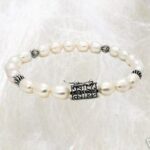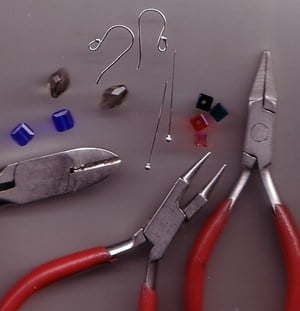Like all gemstones, pearls have different qualities which can make them more beautiful and more valuable than others. Choosing pearls is difficult, however, if you do not know how to judge the value of a pearl by looking at it. As a professional in the jewelry industry, I can offer some simple and helpful advice on how to choose pearls for yourself or someone you love.
Saltwater vs. Freshwater Pearls
Saltwater pearls, or “Akoya” pearls are formed around a large round bead that is usually made from mother of pearl or shell. This is called a nucleus. The nucleus is inserted into the oyster along with a mantle which is a piece of flesh from another oyster. This mantle has a hormone in it which causes the oyster to secrete nacre (nay-cur), a natural product of the oyster that it uses to build its shell. This nacre covers the nucleus and the result is a pearl.
A saltwater pearl is a very thin layer of nacre over a large bead. Saltwater pearls are more difficult to produce and are more valuable than most freshwater pearls. This thin layer of nacre makes them more likely to peel than a freshwater pearl. Because they are only a thin layer of nacre over a large bead, they tend to come out nearly perfectly round.
They can be any shape at all, however, and without x-raying them, it is impossible to tell a saltwater pearl from a freshwater pearl. Tahitian pearls, Akoya pearls, Mikimoto pearls, and South Seas pearls are all saltwater varieties of pearls.
Freshwater pearls are usually made without a nucleus. They are solid pearl all the way to the center. Mussels are impregnated with a mantle and the mussel will secrete nacre which will form pearls of any shape or size. Freshwater pearls can be perfectly round or they can be more intriguing abstract shapes. Freshwater pearls are less likely to peel.
Freshwater pearls are just as beautiful as saltwater pearls, but they can be cultured several to an oyster, so they are easier to produce and therefore less expensive in general. Many people mistakenly believe that saltwater pearls are round while freshwater pearls are all unusual in shape. This is not true at all. Any type of pearl can be any shape or size. You cannot tell a freshwater pearl from a saltwater pearl just by looking at it.
Natural Pearls
Some people want a natural pearl or a pearl which has been formed on its own without being cultured (farmed). These pearls are extremely rare and you are more likely to see one in a museum, not on a piece of jewelry. You would have to open a few hundred thousand oysters in order to find one naturally-occurring pearl. Natural pearls are usually very ugly and are rarely if ever at all round. If you were ever able to see a natural pearl, it will probably be a collector’s item and will not be set into a piece of jewelry.
They can run from several thousand dollars each to several million. In the jewelry industry, there is pretty much no such thing as a natural pearl. All pearls that you will ever see are cultured. Natural pearls are not of a better quality than cultured pearls. They are exactly identical except that a natural pearl formed by accident while a cultured pearl was “helped along” by being started by hand.
Surface Quality
Another desire that many people express is to have a pearl that is perfectly round with no blemishes. These pearls are also nearly nonexistent. A perfect pearl is called a Herman pearl and they are kept as collectors’ items, not used in jewelry. Because a pearl has marks on it does not make the pearl “bad” or invaluable.
On the contrary, because almost all pearls have birthmarks, dents, or bumps, that is only part of the value of the pearl. Think of marks on the pearl as being “marks of authenticity” that tell you that the pearl is real. The fewer birthmarks on the pearl, the more expensive if will be. Check the back of the pearl if you can as many jewelers will hide major abnormalities behind a setting.
Roundness
The more perfectly spherical a pearl is the more valuable it will be. These pearls are rarer and harder to find, especially with large pearls. You will pay more for a round pearl simply because there are fewer of them. Other shapes are just as pleasing to the eye. Some people do not like round pearls because they feel that they look fake. Others prefer the perfectly smooth shape of a round pearl.
If roundness is an issue for you, ask to see the pearl before it is put into the setting. If it is already set, see if the back of the setting is open. Sometimes dishonest jewelers will hide an oblong pearl in a setting to make it appear round. Some will even cut the top off of a pear-shaped pearl and set it so that it appears round. This is a dishonest practice and will dry the pearl out, resulting in its ultimate deterioration.
Sterling Silver Settings
Some who do not want to pay the price of gold will ask for pearls set in sterling silver. This is not advisable. Silver tarnishes and must be cleaned with chemicals or abrasive cleaners which will destroy the pearl. If you do not like the color of yellow gold, opt to have your pearl set in white gold or platinum instead.
Orient of the Pearl
The beautiful colored luster on the outside of the pearl is called its “orient.” This is more pronounced on very metallic pearls which are more likely to show rainbow hues. When you turn the pearl, you will see rings of colors. Not all pearls display this quality. Pearls that are shinier and more metallic are rarer and often will be more expensive, but only slightly.
Size
Many pearl buyers are also concerned with the size of the pearls. Larger pearls take longer to produce, so you are going to pay more for the time it took to create them. Larger pearls are not of better quality and are not necessarily rarer. Don’t worry much about the size of your pearl unless you just really like big chunky pearls. A pearl that is slightly larger than another will probably have the same value. Only much larger pearls will be worth more.
Color
Color is a little more complicated with pearls because the colors you can get are different with each type of pearl. “Dyed” means just that: the pearl has been dipped in colored dye. This is rarely done and the results are not often pretty. The colors often look extremely unnatural or overly bright. A dyed pearl will have darker areas of dye in and around blemishes and creases. These pearls are very inexpensive and the dye may wear or fade.
“Color enhanced” pearls are not dyed. They are colored by adding silver nitrate to the water where the oysters lived. Color enhanced pearls hold their color and will not fade. Silver, gray, light blue, plum, and variations of black can be produced this way. Color enhanced pearls are slightly more valuable than natural colored pearls.
Saltwater pearls are naturally white to yellowish or gold. Freshwater pearls can be naturally either of these colors as well as variations of pink or peach. Only Tahitian pearls can be naturally black. Pearls can be dullish to highly metallic and the color you choose is about personal choice and has little to do with the pearl’s value except in the case of yellow gold pearls which are very rare.
Mikimoto Pearls
Mikimoto is a brand name, it is not a type of pearl. Mikimoto pearls are exactly like any other pearl. They only cost more because they are being sold in the Mikimoto store. You will not find Mikimoto pearls in a regular jewelry store. You would not, after all, go into a regular jewelry store and ask for a Tiffany’s diamond, right? Only you would know that you are wearing a Mikimoto pearl or a diamond that came from Tiffany’s.
Tahitian Pearls
Tahitian pearls are the world’s only naturally black pearl. These pearls come from a very large species of oyster called the “black-lipped oyster.” The pearls are not actually black, but silver to dark gray in color. They may also include other colors such as green, pink, violet, or blue over the gray undertones. Some are silver in color and some are rainbow colored (called “peacock”). Some people think that the darker black a black pearl is, the more valuable it is, but this is not true. Color has little, if anything, to do with the value of a Tahitian pearl. Popular colors change every year with fashion, so just choose the color that you like best. Because the oysters that make them are so large, Tahitian pearls are some of the world’s largest pearls. They cannot legally enter the United States unless they are at least 7mm in diameter. They can be any shape and any color from light silver to dark gray.
South Seas Pearls
South Seas pearls are a very close cousin to Tahitian pearls. Even the oysters are similar. South Seas pearls are grown in Australia and Indonesia and grow in the “gold-lipped oyster.” They are very large and range in color from pure white to pinkish gold to very dark gold with the gold pearls being the rarest and most valuable in the world. South Seas pearls are more valuable than any other pearl, including Tahitian black pearls.
Matching Pearls
Because pearls so rarely match, matched pearls are more valuable than single pearls. A single pearl may be worth $20, but a perfectly matched pair of earrings may be $60 simply because the pearls are so alike. Just the same, it is even more difficult to match a strand of pearls. One pearl may cost $20, but the entire strand of pearls may cost several thousand dollars simply because they match so well. A strand of Tahitian pearls that is well-matched may take several years to produce. The better a strand of pearls is matched, the more valuable it will be, especially if the pearls are a rarer type.
Pearl Myths
Some consumers believe that pearls are unethical because of the dangers that the pearl divers encounter when harvesting the pearls. Pearl diving ended long ago and pearls are no longer dived for anywhere in the world except by enthusiasts. Pearls are grown in floating baskets on farms in the ocean which are pulled up periodically to remove the pearls from the oysters inside the nets.
There is a very recent myth that pearls are unlucky to wear on your wedding day because “pearls bring tears.” This is true, but it is taken out of context. The tears are tears of joy, not tears of sorrow. White pearls are a symbol of truth and purity and are traditional to wear when getting married. Many cultures believe that pearls are a symbol of love, luck, and good health.
Some people who are animal rights activists will not wear pearls because they feel it is exploitation of animals. Some pearls are and some pearls are not. Most oysters are killed when they are harvested for their pearls. The oysters which produce Tahitian pearls and South Seas pearls are not killed, however. They are protected by law. Their pearls are extracted gently and replaced with new nuclei every few years. Once they are too large to handle, they are released, not killed.
Most people are under the impression that a pearl is an “irritation” to the oyster. We cannot know for sure, but it is generally understood that the pearl does not irritate the oyster in any way. A grain of sand or other sharp object may cause irritation for a very short time, but a cultured pearl is smooth and made from shell and will not irritate the oyster any more than its own shell will irritate it. Oysters do not coat pearls with nacre because they are irritated by it. The pearl is simply coated as the oyster releases nacre naturally to build its own shell. It is an accidental byproduct of the oyster’s natural function.
Caring for Your Pearls
Pearls are not difficult to care for and not as delicate as you might think. They are okay to wear every day, but you should take a few precautions. Pearls should not be worn with other gems as they can scratch them. Keep pearls separate from your other jewelry in your jewelry box where they cannot be scratched by diamonds or other stones. Do not get any chemicals on your pearls, especially perfume, makeup, or hairspray as it will ruin them. Pearls should be the last thing you put on when getting ready.
Never wash pearls with jewelry cleaner. It dissolves them. Use extra virgin olive oil or a plain soft natural cloth instead. Pearls need oils to stay moist or they will crack or peel. Wear them against your skin often or lightly rub them with a few drops of olive oil on a soft cloth. Do not store them in a safety deposit box and wear them as often as you can.
Never hang a strand of pearls. Lay them flat when you are not wearing them. Pearls strung on silk will need to be restrung every few years. Try not to get any olive oil in the string of your strand. Do not wear pearl necklaces over a polyester shirt. The constant rubbing during the day will wear the pearls. A pearl that is scratched or not cared for can never be repaired.
With a little care, your pearls will look new for generations to come. Have fun pearl shopping and remember: you will be happier with a pearl because you like the way it looks, not because it is rarer or more valuable than another. Stick to what you find beautiful.




